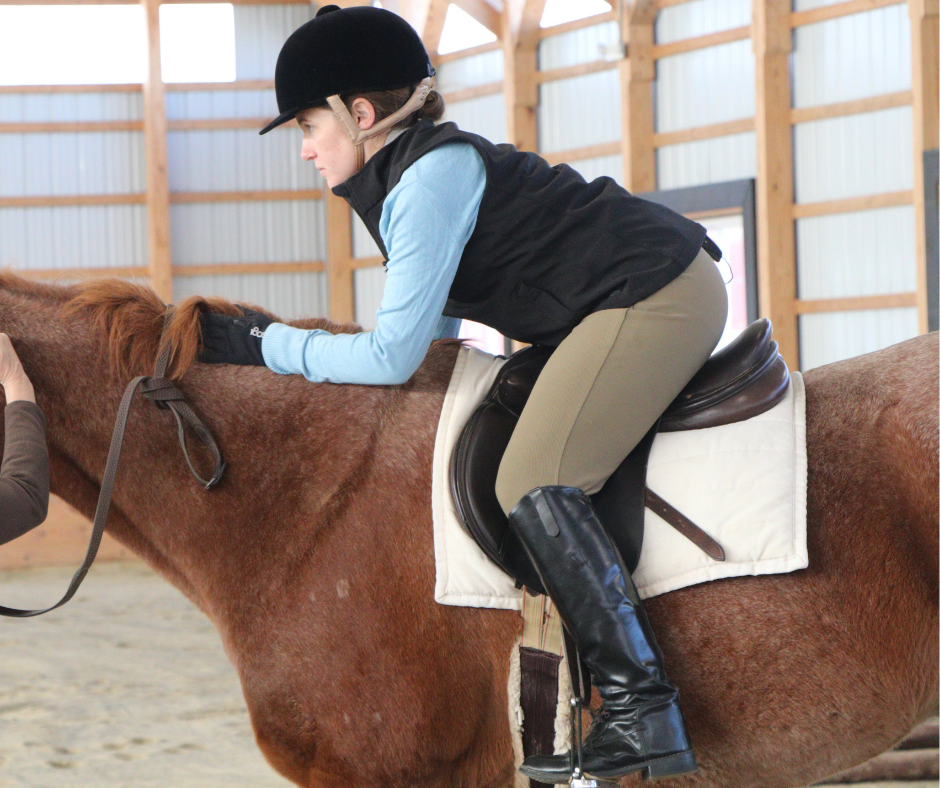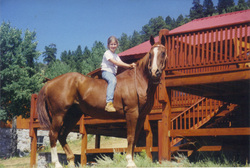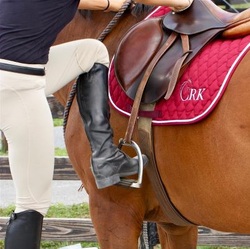For many riders, preparing to jump for the first time, or working to improve their jumping, begins with spending time holding the two point position. Perhaps just standing still at first, and then at walk, trot, canter, and even over poles.
Practicing this basic position is great, but there is a catch…
The way many people learn to practice two point, actually reinforces the movement patterns that will have you leaning at the jump, collapsing onto the neck, and generally feeling unbalanced while jumping.
In this video, I demonstrate a simple distinction in how to practice your two point position, beginning while simply standing still.
Watch the video and see if you are doing this too!
** The position I am going to show here is also very useful for going up hills, so even if you don’t jump, but you do trail ride, this will be helpful to watch!














77 Responses
Remaining loose at the joints is hard for me. I lean forward, but when my horse goes to jump, my seat still comes up and I’m ‘thrown’ forward – almost over the horse’s neck.
Judging the strides
My biggest jumping problem is feeling when it’s time to fold at the hip. I think too much and fold early or late instead of letting the movement of the horse dictate the fold
Melissa, I would recommend incorporating the grids (like the one in this video that the student is riding through) so help you find that correct timing of when to assume your jump position!
-Julia Burdy, CRK Training Community Manager
i agree with you we do grids to improve are jumping postion my riding instuctor its always telling me look at the jump turn look straight ahead
Hi, this thing I find most difficult is not adopting the jump position too soon and getting back up quickly after the jump.
I am not a jumper, but watching the unsafe heavy on the forehand position of the jump riders has made me cringe for years. I am enthralled and thrilled to see some sensible riding position being taught. I applaud you!
I find it challenging to see distances to fences. I often get anxious and end up doing too much to try to get the “perfect” distance and that just makes it more difficult for me and my horse.
Nancy, try to think about your rhythm to the fence instead of seeing a distance – this is something that has greatly improved my eye personally!
-Julia Burdy, CRK Training Community Manager
The most difficult thing about jumping is that I think : what if he/she doesn’t jump,makes a refusal and I am thrown over the bars ….. Whenever I think that way , something bad would happen !
I am not a show jumping rider and I just did some little inhouse tournament . This is my experience.
Firstly I love your sessions – short sweet and informative. Thankyou.
My problem with jumping is that I fold- think I’m moving my arms and hands with the horse but photos show me folding over my hands. Have you any tips to get me out of this habit? Is it my balance?
Meredith, I would recommend practice your jump position at a stand still and on the flat. From what it sounds like you may not be allow your butt to go back far enough in the saddle for how much you are folding. Also, it is important to note that we don’t have to fold very much (especially over smaller jumps) and it is actually the horse that closes the space between our body and theirs.
-Julia Burdy, CRK Training Community Manager
Thank you it was useful,I start jumping from one week ago .
The thing I find the most difficult about jumping is getting the correct grip with my legs. My instructor is always reminding me to “close my leg” around my horse or “use more leg”. It seems as though I can’t get the right feel of my leg on the horse.
I’m an older rider (57) riding my daughter’s horse- a 19 year old quarter horse (Daisy). Daisy used to be a lesson horse before we bought her- and she was used for jumping. She developed navicular- which is under control with bute and front foot pads… that’s just a little background that I think you should know… So… I am the one who spends the most time riding Daisy- it has taken me the last four years to develop strength and balance and enough confidence to even consider jumping (I did some jumping 20 years ago on a horse who knew her job). The challenge that I face is getting Daisy to go forward – her default is to slow down/walk – which, to be honest, was really just fine with me while I was building confidence- but now I need her to keep going forward – I spend a lot of time thinking about me- and it’s hard for me to think about me and Daisy at the same time! I can’t afford to pay someone to “put rides” on her- so I’ve got to figure it out myself. I’m not currently working with a trainer- so your videos are very helpful!
Barbara, I would recommend starting with our riding a lazy horse video to help you school her on the flat to get her a little more in front of your leg which will actually make jumping a little safer than going too slow 🙂
-Julia Burdy, CRK Training Community Manager
I really like jumping but i am scared that my horse stops right before the jump. I have a Tinker horse with a short neck. Its not realy a jumping horse haha . So my question is how can i make sure he dus not stop before the jump? Sorry if my English is not so good, i live in Holland. Greetings from Angelique.
Hello Angelique from Holland, happy to have you here on the blog! 🙂 If he is just getting started with jumping I would recommend following the exercises in this blog video about starting young or green horses under saddle!
-Julia Burdy, CRK Training Community Manager
balancing my horse after a jump
It seems I have to use a different approach to my seat with a horse who bascules, hurdles the jump, instead of jumping flat. Most of the horses I have jumped have been flat jumpers, which I do fine on, but I am still landing on the neck of those who prefer to hurdle.
Susan, I have a horse that really bascules over the fences (which by the way is a really good trait for a jumper!) and it helps to practice opening the hip angle and keeping your eyes forward to absorb the movement.
-Julia Burdy, CRK Training Community Manager
Hi,
One of my problems was/is that I would come to the two point position much too early and not at the jump. I would try to sit the canter till the jump point but would get nervous and take the two point position many strides before the jump.
Regards
Sathya
Sathya, if you notice the clip of the student riding over a grid those can be great for working through this tendency of getting ahead to the fence and practice staying back and allowing the horse to jump to you!
-Julia Burdy, CRK Training Community Manager
one of the issues I had is learning to wait for my horse to jump and not jump ahead of him
Riding ahead-too far forward too soon. Not sinking into my heels.
Dear Callie, nice video, thank you. For me it is looking forward! When I do not pay attention, I look downward, which affects my balance.
Me too.
Ellen, yes that will definitely have a considerable impact on your position – we always want to be looking for the next jump when we are on course 🙂
-Julia Burdy, CRK Training Community Manager
Hi
I find working out how much room I have to position the horse and how many strides I have before the next jump.
Hi Callie Horse rushing at fences and getting himself too deep he has always “locked on” but this is different
Dawn, we’ve got great exercises for those types of behaviors in our Building the Showjumper course we are putting together with Angelo Telatin!
-Julia Burdy, CRK Training Community Manager
I have a problem rebalancing myself as the horse lands the jump
Very thought provoking and something certainly not taught by many,many trainers.
Balancing on my horse during the jump
Thanks for this video!
Biggest issues: not anticipating (most commonly with a horse I trust will jump), or not gripping with my knees when I ride a green horse who may stop. I KNOW am not supposed to do either, but sometimes anxiety prevails.
Amanda, that is totally natural! Our nervous system takes over sometimes 🙂
-Julia Burdy, CRK Training Community Manager
Hello,
My problem is that my reins always get longer during the jump (I don’t want to hurt my horse mouth so I open my fingers a little during the jump) so it makes it hard to balance my horse after the jump. I also feel like I don’t have time to think while I’m jumping more than a jump.
Thanks
Solenne, these are very common challenges which is why we put exercise in Wendy’s jumping course to achieve a following hand and help develop the skills you need to be in the correct position over the fences!
-Julia Burdy, CRK Training Community Manager
Thank you so much for this! As with anything in riding, it is east to overdo the position/movement. I am very excited about the upcoming videos – I have always wanted to learn how to do a few small jumps. Also, what kind he of bitless bridle is that?
Again, thank you!
Hi Mary! It is sidepull style bit-less bridle! We have a whole video on the pros and cons of different styles of bit-less bridles if you click here 🙂
-Julia Burdy, CRK Training Community Manager
Thanks for drawing our attention to the 2 point position and its correct execution. Will practice that! Our biggest challenge is judging the strides to the jump. It is soo hard.
Meike, I responded to another comment about this but if you keep thinking about the rhythm and counting as you are cantering to the jump it can really help! Even if you set two ground poles and walk a distance between the two and then practice counting that can be a great exercise to start developing your eye.
-Julia Burdy, CRK Training Community Manager
Finding the spot.
Carole, it really helps to think instead of just the spot finding the right rhythm to the jump!
-Julia Burdy, CRK Training Community Manager
Guilty as charged! I am no longer a jumper but I still use cavalettis and small jumps to work on my balance and buttocks and leg strength. (Plus it is fun). I do find myself placing way too much weight into my heels instead of centering…argh
Jumping is so much fun! I think it really helps to remember what Callie mentioned about not getting too far out of the saddle – that may help you with standing in the stirrups 🙂
-Julia Burdy, CRK Training Community Manager
My biggest challenge is maintaining a balanced position over the jump so I don’t either collapse on my horse’s neck or get left behind. This issue was further complicated when I started to have lower back issues and begin bracing my abdominal muscles and hunching my lower back over the jumps. I like the simple way you explained the alternative method in the video. Thanks!
Maggie, glad you enjoyed the video! One piece of advice that has really helped me is thinking about the horse coming up to you inside of folding down the on the horse. That way you leave space for the horse’s wither to come up and use themselves well over the jump!
-Julia Burdy, CRK Training Community Manager
Hardest part I find is keeping my lower leg still and not loose, so as to feel unbalanced
That can be really tricky Anna, make sure you aren’t bracing on the stirrup or in any of the joints in your hip, knee, or ankle as that can create a pivot point that results in destabilizing your position!
-Julia Burdy, CRK Training Community Manager
Hi Callie – thanks so much for all the awesome videos you make, I really really enjoy them!
I was absolutely taught to stand in the stirrups over jumps and am slowly breaking the habit. My question/problem I am working on: I am quite tall and most of my height comes from my upper body – when I try to fold at the hip I often lose my balance and end up tipping my center of gravity forwards. I also frequently fold in my shoulders/upper back instead of keeping my chest open. Do you have any tips for people with my body type? I am working on a core strength program designed for equestrians to see if that helps but any tips you have would be much appreciated!!
Thanks again!
Georgina
Georgina, although it is difficult to say without seeing what exactly you are doing but it sounds like you may not being moving your butt back far enough in the saddle or perhaps if the saddle doesn’t have enough room for you to do so it could be preventing you from folding properly. We have great exercises in the course for keeping your chest open 🙂
-Julia Burdy, CRK Training Community Manager
Hi Callie! Loved this video. Wish I had seen it 4 months ago before I had a fall while doing a jump. I’m not yet back to riding but love your videos! Thanks for the info.
Sorry to hear about your fall Eileen 🙁 Hope you’ll check out the course when it become available so it doesn’t happen again!
-Julia Burdy, CRK Training Community Manager
Guilty of all of the above, but I have two issues I’ve been struggling with for the most part. Following her head with my hands over the jump and balance recovery after the jump.
Jane, if you can start practicing this two point in halt or walk it may start to help with that! Plus, we have great exercises for developing those skills in Wendy’s jumping course 🙂
-Julia Burdy, CRK Training Community Manager
Hi Callie,
Great video, never thought about this before. I was wondering, in the position you talked about, do you not sink your weight into your heels? I guess I am a bit confused about what you mean by not bracing against the stirrups. It seems like most of your weight should be carried on your thighs rather than in your heels?
Thanks!
Hi Lydia, these are great questions! I am going to link to two videos on riding with your thigh and what heels down really means that we did on the blog awhile ago that can explain it much better than I can in a comment 🙂
-Julia Burdy, CRK Training Community Manager
Where is your teaching school ( location ) and do u have training related to horse racing ( equestrian trainer ) i m very passionate about horses and planning on joining for
equestrian trainer courses.
Hi Anas, we are located in Honey Brook, PA but our online courses are available no matter where you call home! You can click here to read more about what we have to offer.
-Julia Burdy, CRK Training Community Manager
Not up to jumping my new horse yet, but, technical question, what sort of bitless bridle is the horse in the video wearing? Looking for one for my new gelding, he doesn’t seem very enthusiastic about any of it thus far. Many thanks!
Hi Ditte, it is a side pull style bitless bridle! We actually have a video about different types of bitless bridles right here on the blog!
-Julia Burdy, CRK Training Community Manager
I have a difficult time finding the right take off point. My horse either jumps too early or too late. Consequently I am not always in the proper position. I also have a problem sitting before he jumps and am too far out of the saddle. Any suggestions?
Nancy K
Hi Nancy, when approaching a single fence the rhythm to the fence is really important for seeing the correct distance to the fence. Have you practiced any grid work with him?
-Julia Burdy, CRK Training Community Manager
Having ridden bareback for most of my childhood and practiced jumping with my beloved pony often knotting the reins on the neck and then ‘flying’ through grids I’ve never had that issue. But striding is still hard even after 55 years of riding/jumping. Rhythm is fine and counting aloud is fine but when jumps get over 1m you can’t afford to be 1/2 stride out.
Fiona, that is why starting the really low fences is the safest option!
-Julia Burdy, CRK Training Community Manager
Hi Callie! I find it difficult to be in the moment when I am going over a jump. I find myself sort of just being taken over and I do not jump as calmly as I would like. If I could be more in the moment, I feel like I coud then work on my technique more.
P.S. Thank you for your amazing instruction videos they have helped me so much!
Eliza, that is why we love the grid exercises for horse and rider – great for expanding the moment of the jump to get the feeling of being in the correct position!
-Julia Burdy, CRK Training Community Manager
That sounds exactly like what I need. Where can I find them?
Eliza, you can find them at http://www.effortlessjumpingcourse.com and http://www.buildingtheshowjumper.com !
-Julia Burdy, CRK Training Community Manager
What I find very difficult while jumping is stay put and wait when arriving on the fence, especially in the last 5-4 strides. I know that if the balance, activity and approach trajectory are good (sorry I do not know the technical word in English,, in French we say tracé for the route we take to go towards the fence) then the horse can and will manage the jump, that if all the preparation is well done and all is going fine then I definitely must not do anything that will surprise or bother the horse just before the fence, because I will probably make it more difficult for the horse to jump. But though I love jumping, it is very difficult for me to stay “neutral” and wait and with the stress, I often overact and do some last minute adjustment that atually ruin all I might have done ahead to prepare the jump, or I anticipate the jump, which also unbalances the horse at the worst possible moment… I tell myself while the fence is getting closer to just”wait, wait, wait” but it is very difficult, so if you have an advice to help in this situation it would be great
And thank you very much for all the nice insights you share, I enjoy wathing the videos very much.
Hi Caroline, this is totally normal and something a lot of riders struggle with when it comes too jumping. I would highly recommend signing up for updates on the upcoming jumping courses with Angelo and Wendy, they have exercises in the course that will immensely help you with this problem!
-Julia Burdy, CRK Training Community Manager
Hi Callie:
Thank you for this video it is very helpful. Most often my horse rushes at the jump and all I can think about it just staying on and making it to the other side. I would find it helpful to learn some techniques to gain better control at the approach.
Hi Callie,
I think my most difficult thing when jumping is probably keeping a straight back without bending over the jump. Also getting good strides and having enough even strides to get over the jump correctly without over jumping on my horse.
Thanks so much! (I also love your videos and they are very helpful)
Hi Jade! Jumping habits are so hard to break, that is why Wendy Murdoch uses a wide variety of tools and unmounted exercises to break those habits! You can learn more about her Effortless Rider Jumping Course by clicking here.
-Julia, CRK Training Community Manager
i think the hardest part about two point its staying out of the saddle
Hi Emma, hopefully the tips on this video make it easier for you practice the two point!
-Julia Burdy, CRK Training Community Manager